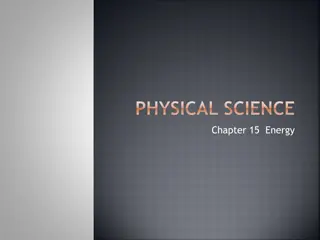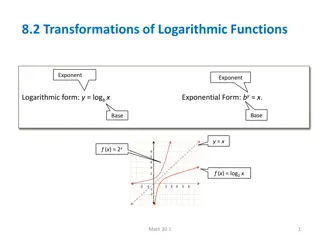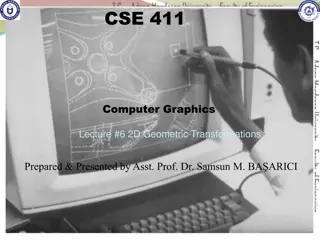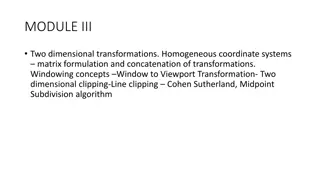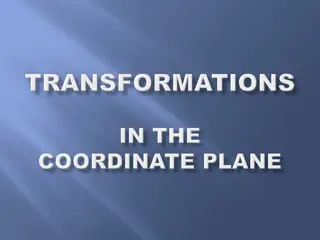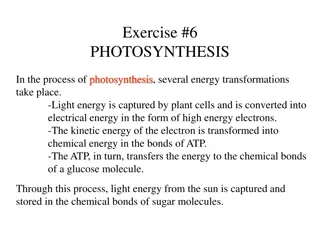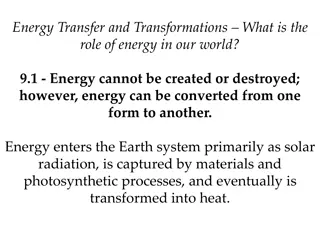Understanding Energy Transformations in Science
Investigate the relationship between potential and kinetic energy, explore energy transformations, differentiate between types of energy (kinetic, potential, chemical, etc.), and grasp the Law of Conservation of Energy. Discover how energy changes from one form to another through various examples and scenarios.
Download Presentation

Please find below an Image/Link to download the presentation.
The content on the website is provided AS IS for your information and personal use only. It may not be sold, licensed, or shared on other websites without obtaining consent from the author. Download presentation by click this link. If you encounter any issues during the download, it is possible that the publisher has removed the file from their server.
E N D
Presentation Transcript
ENERGY TRANSFORMATIONS Essential Question: What is the relationship between an object s potential and kinetic energy? SC.7.P.11.2 Investigate and describe the transformation of energy from one form to another. Also Assesses: SC.6.P.11.1 Explore the Law of Conservation of Energy by differentiating between potential and kinetic energy. Identify situations where kinetic energy is transformed into potential energy and vice versa. SC.7.P.11.3 Cite evidence to explain that energy cannot be created nor destroyed, only changed from one form to another.
BELL RINGER Tabitha ate a turkey sandwich and an apple for lunch. Later that day, she ran 2 miles during soccer practice. Which of the following energy transformations occurred between lunchtime and the end of Tabitha s run? A. Thermal energy was converted to kinetic energy. B. Kinetic energy was converted to chemical energy. C. Electrical energy was converted to thermal energy. D. Chemical energy was converted to mechanical energy.
TYPES OF ENERGY I DO Kinetic Energy: the energy of motion Ex: a book falling to the floor. Potential Energy: stored energy (an object could POTENTIALLY move) Ex: a book sitting on a shelf
MORE TYPES OF ENERGY I DO Chemical Energy- Stored energy in compounds. Light Energy- Electromagnetic Energy Travels as radiation. Heat Energy-Transfer of molecular kinetic energy(Hot Cold) Mechanical Energy- Transferred by moving parts. Sound Energy- Caused by vibrations in matter. Electrical Energy-Charged particles that follow a path.
GRAVITATIONAL POTENTIAL ENERGY Gravity: the force of attraction between two objects with mass. Gravitational Potential Energy: The amount of stored energy can be different depending of the distance it could fall. The farther you fall, the greater the GPE!
POTENTIAL AND KINETIC ENERGY IN DIFFERENT FORMS OF ENERGY Chemical Energy: Potential Chemical: Energy stored in batteries. Kinetic Chemical: Batteries powering your electronics. Mechanical Energy: Potential Mechanical: Parts of your bike could move. Kinetic Mechanical: Parts of your bike create movement when you move the pedals.
LAW OF CONSERVATION OF ENERGY Law of Conservation of Energy: Energy cannot be created or destroyed, only changed from one form to another.
YOU DO QUESTION #1 The government is exploring many new green technologies in order to produce energy. One example is the wind turbine. As the wind passes by, the blades move which turns a generator and produces energy. What energy transformation is taking place in the wind turbine? a) Kinetic energy transformed to potential energy b) Chemical energy is transformed to kinetic energy c) Kinetic energy is transformed to mechanical energy d) Mechanical energy is transformed to kinetic energy
YOU DO QUESTION #2 Harry uses a pulley to put up a bucket of water from a well. He uses chemical energy in his body to apply mechanical energy to the system. Which of the following energy transformations also occurs as the bucket rises? A. Energy is gained as potential energy is transformed to kinetic energy. B. Energy is gained as kinetic energy is transformed to potential energy. C. Energy is conserved as potential energy is transformed to kinetic energy. D. Energy is conserved as kinetic energy is transformed to potential energy.
YOU DO QUESTION #3 Ryan and his family are visiting a theme park and he wants to ride a roller coaster. At which point in the diagram would he expect to have the greatest amount of potential energy? a) Point W b) Point X c) Point Y d) Point Z
EXIT TICKET Essential Question: What is the relationship between an object s potential and kinetic energy?





